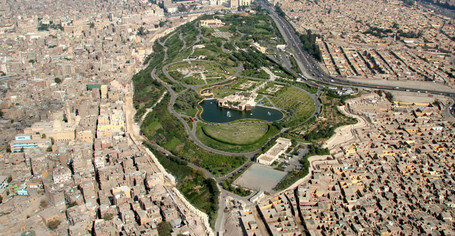
Picture: Aga Khan Trust for Culture
Source: www.uclg-cisdp.org
The Inclusive Cities Observatory is a space for analysis and reflection on local social inclusion policies managed by the Committee on Social Inclusion of UCLG. Among these case studies, the Committee presents a study based on the rehabilitation of Al-Darb al-Ahmar in favour of 285 families, an historic district in Cairo, Egypt.
Case Study
Al-Darb al-Ahmar is an historic district in Cairo, and its 100,000 inhabitants are among the poorest. While featuring rich concentration of Islamic monuments, Al-Darb al-Ahmar suffers from a lack of adequate infrastructure and services, as a baseline survey revealed in 2003 (e.g., lack of private lavatories, water sources, and ventilated rooms in dwelling units). Consequently, an alarming percentage of residents complain of health-related issues. In an effort to consolidate the existing urban fabric, the HRP was established to improve the quality and quantity of housing and to meet health standards, while maintaining original architectural features and fairly providing secured tenure.
The Al-Darb al-Ahmar Housing Rehabilitation Programme (ADAA HRP) was started in 2004 with a target of 200 houses by the deadline of end of 2009. After the launch phase, it is an ongoing programme but dependent on the action of local communities and new contributions from several donors. The HRP aims to improve the quality and quantity of responsive housing through rehabilitation, achieving long-term sustainability. HRP formulated a multidisciplinary strategy to tackle the principal causes underlying housing decay, in cooperation with all stakeholders:
- Revise the institutional mechanisms to bridge the gap between legislative policies and residents’ needs;
- Facilitate the residents with access to housing grants and affordable loans;
- Improve security of tenure through resolution of legal conflicts between owners, tenants, and institutional organizations; and
- Promote higher conservation standards through advice, training, and monitoring of construction activities.
The project specificities
The beneficiaries of the programme are the inhabitants of the al-Darb al-Ahmar district, and several local community groups and enterprises.
The participation processes implemented included vast surveys of the urban, social, and economic needs of the local residents. Numerous meetings were held to identify the priorities of conservation and development as perceived by the local community. Through negotiations with the residents, priorities were set, including the refurbishing of historical houses and buildings, spaces, and public areas, and the funding needs for small projects, health services, and centres for local community development were determined. A pre and post satisfaction survey covering all beneficiaries is the main measuring tool. Direct observation and community group interview techniques are also used to measure changes in value, rent, and number of new home assets.
The HRP approach and implementation has resulted in innovations in several policy schemes. The Supreme Council of Antiquities changed its demolition policies that had led to the eviction of hundreds of families from Al-Darb al-Ahmar. Accordingly, Cairo Governorate revised the 1973 District Plan which allowed for massive demolitions based on the SCA policies and in 2008 ratified the new Conservation Plan for Al-Darb al-Ahmar. In 2007, the National Organization for Urban Harmony identified the HRP as a best practice in its ‘Guidelines for Historic Areas’ to be implemented on the national level. In 2008, the Cairo Governorate modified the legal requirements for the rehabilitation of existing housing stock in order to promote a better rehabilitation process.
The Al-Darb al-Ahmar HRP is a component of the larger ‘Azhar Park Project’ of the Historic Cities Support Programme of Aga Khan Trust for Culture (AKTC), and is supported by grants from several institutions (Egyptian-Swiss Development Fund, Ford Foundation, World Monuments Fund, AKTC, Social Fund for Development, and Canadian International Development Agency).
For more information, please consult the full case study : Inclusive Cities Observatory.










